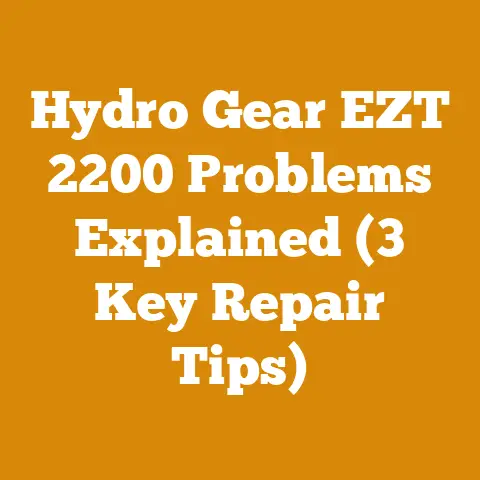Vermeer S600 Mini Skid Steer Review (Kubota Diesel Power Tested)
Vermeer S600 Mini Skid Steer Review (Kubota Diesel Power Tested): A Cost-Conscious Woodworker’s Perspective
Let’s talk about resale value. That’s where I always start when I’m considering a new piece of equipment, especially something as significant as a mini skid steer. It’s not just about the initial investment; it’s about what you can recoup down the line. The Vermeer S600, powered by a Kubota diesel engine, is a popular choice in the landscaping and light construction world, and increasingly, among those of us involved in wood processing and firewood preparation. Its reputation for durability and versatility certainly contributes to its resale appeal. But is it really worth the investment for our niche? That’s what I aim to dissect in this review, focusing heavily on the cost implications for woodworkers like myself.
I’ve spent years wrestling logs, splitting firewood by hand (and machine!), and generally learning the hard way about the true costs of wood processing. From felling trees in the back forty to delivering cords of seasoned oak, I’ve seen firsthand how the right equipment can make or break a project, both in terms of efficiency and profitability. This isn’t just a technical review; it’s a practical guide, informed by real-world experience, to help you determine if the Vermeer S600 is the right tool for your wood processing needs, and more importantly, if it fits within your budget.
The Allure of the Mini Skid Steer: Why Consider the S600?
Before we dive into the nitty-gritty of costs, let’s address why a mini skid steer is even on the radar for woodworkers. Traditionally, we rely on tractors, ATVs, or even sheer manpower to move logs, load firewood, and manage debris. A mini skid steer, like the Vermeer S600, offers a compelling alternative:
- Maneuverability: Its compact size allows access to tight spaces where larger equipment simply can’t go. Think dense forests, small woodlots, or even residential properties.
- Versatility: With the right attachments, it can perform a wide range of tasks, from grapple work to brush clearing to augering post holes.
- Power: The Kubota diesel engine provides ample power for lifting heavy loads and tackling demanding jobs.
However, all these benefits come at a price. And that price isn’t just the initial purchase; it’s the total cost of ownership, including maintenance, fuel, attachments, and potential repairs.
Unpacking the Initial Investment: Purchase Price and Financing
The most obvious cost is the purchase price. A new Vermeer S600 typically ranges from $35,000 to $45,000, depending on options, attachments, and dealer markups. Used models can be found for significantly less, but condition is paramount.
- New vs. Used: A new machine offers the peace of mind of a warranty and the latest technology. A used machine can save you a considerable amount of money upfront, but you’ll need to factor in potential repair costs. I’ve personally bought both new and used equipment, and I’ve found that a thorough inspection by a qualified mechanic is always worth the investment when considering a used purchase.
- Financing Options: Most dealers offer financing options, but interest rates can vary widely. Shop around for the best terms. A good credit score will be your best friend here.
- Leasing: Leasing can be an attractive option if you don’t want to tie up capital or if you only need the machine for a specific project. However, leasing typically comes with higher overall costs in the long run.
Data Point: According to a recent report by EquipmentWatch, the average interest rate for equipment financing in Q3 2023 was 7.5%. This figure can fluctuate based on market conditions and your individual creditworthiness.
My Experience: When I purchased my firewood processor, I explored both financing and leasing options. Ultimately, I opted for financing because I knew I’d be using the machine for years to come. However, if I were only planning on using the S600 for a specific project, leasing might have been a more cost-effective choice.
Kubota Diesel Power: Fuel Consumption and Maintenance Costs
The Kubota diesel engine is a major selling point of the Vermeer S600. It’s known for its reliability and fuel efficiency. However, diesel engines do require regular maintenance, which can add up over time.
- Fuel Consumption: Expect to burn around 1.5 to 2 gallons of diesel fuel per hour of operation, depending on the load and operating conditions. Diesel prices fluctuate significantly, so it’s important to factor this into your budget.
- Maintenance Schedule: Regular maintenance includes oil changes, filter replacements, and fluid checks. Consult the owner’s manual for the recommended maintenance schedule. I’ve found that sticking to the recommended schedule can significantly extend the life of the engine and prevent costly repairs down the road.
- Repair Costs: Diesel engine repairs can be expensive. Be prepared for potential repairs, such as injector replacements, fuel pump repairs, or even engine overhauls.
Data Point: According to a survey of small business owners, the average cost of diesel engine maintenance is around $500 per year. This figure can vary depending on the age and condition of the engine, as well as the frequency of use.
My Tip: I always keep a detailed maintenance log for all my equipment. This helps me track maintenance costs, identify potential problems early on, and ensure that I’m adhering to the recommended maintenance schedule. I also recommend learning basic maintenance tasks yourself. It can save you a lot of money in the long run.
Attachments: Expanding Capabilities and Adding Costs
The versatility of the Vermeer S600 is largely determined by the attachments you use. Common attachments for wood processing include:
- Grapple: For moving logs and brush.
- Bucket: For loading firewood and clearing debris.
- Auger: For drilling post holes for fencing or other structures.
- Hydraulic Wood Splitter: For splitting firewood.
- Stump Grinder: For removing tree stumps.
Each attachment adds to the overall cost of the machine.
- Attachment Prices: Attachment prices vary widely depending on the type, size, and manufacturer. Expect to pay anywhere from $1,000 to $10,000 per attachment.
- Used Attachments: Consider purchasing used attachments to save money. Just be sure to inspect them carefully for wear and tear.
- Attachment Storage: You’ll need a place to store your attachments when they’re not in use. This may require additional storage space or a dedicated attachment rack.
Data Point: According to industry experts, the average cost of a new grapple attachment for a mini skid steer is around $3,000.
My Strategy: I prioritize attachments based on my most frequent needs. A grapple and a bucket are essential for my wood processing operations. I then add other attachments as needed, based on specific projects.
Labor Costs: Operating and Maintaining the Machine
Operating and maintaining the Vermeer S600 requires labor, whether it’s your own time or the time of hired employees.
- Operator Wages: If you’re hiring an operator, factor in their hourly wage, as well as any benefits or insurance costs. The average hourly wage for a mini skid steer operator is around $20 to $30 per hour, depending on experience and location.
- Maintenance Labor: If you’re not performing maintenance yourself, you’ll need to factor in the cost of hiring a mechanic. Mechanic rates typically range from $75 to $150 per hour.
- Your Own Time: Don’t forget to factor in the value of your own time. Even if you’re not paying yourself an hourly wage, your time is valuable. Consider how much time you’ll be spending operating and maintaining the machine, and whether that time could be better spent on other tasks.
Data Point: According to the Bureau of Labor Statistics, the median hourly wage for heavy equipment operators in May 2022 was $26.92.
My Approach: I try to do as much maintenance as possible myself to save on labor costs. However, I’m not afraid to hire a professional when I’m dealing with complex repairs. I also carefully track the time I spend operating the machine, so I can get a better understanding of the true cost of each project.
Transportation Costs: Getting the Machine to the Job Site
Transporting the Vermeer S600 to the job site can add to the overall cost, especially if you’re working in remote locations.
- Trailer Purchase or Rental: You’ll need a trailer to transport the machine. You can either purchase a trailer or rent one as needed. A new trailer can cost anywhere from $2,000 to $5,000, while rental rates typically range from $50 to $100 per day.
- Fuel Costs: Factor in the cost of fuel for transporting the machine. The amount of fuel you’ll need will depend on the distance to the job site and the fuel efficiency of your tow vehicle.
- Permits and Licenses: You may need permits or licenses to transport the machine on public roads. Check with your local authorities for specific requirements.
Data Point: According to a survey of equipment owners, the average cost of transporting a mini skid steer is around $1 per mile.
My Recommendation: If you frequently need to transport the machine, purchasing a trailer is likely the most cost-effective option. However, if you only need to transport it occasionally, renting a trailer may be a better choice.
Insurance and Taxes: Protecting Your Investment
Don’t forget to factor in the cost of insurance and taxes.
- Insurance: You’ll need insurance to protect your investment in case of accidents, theft, or damage. Insurance rates vary depending on the value of the machine, your location, and your driving record. Expect to pay anywhere from $500 to $1,500 per year for insurance.
- Property Taxes: You may be required to pay property taxes on the machine, depending on your location. Tax rates vary widely, so check with your local authorities for specific requirements.
Data Point: According to a report by the National Association of Insurance Commissioners, the average cost of commercial vehicle insurance in 2022 was $1,200 per year.
My Advice: Shop around for the best insurance rates. Get quotes from multiple insurance companies before making a decision. Also, be sure to factor in property taxes when calculating the total cost of ownership.
Depreciation: The Silent Cost
Depreciation is the gradual loss of value of an asset over time. The Vermeer S600, like all equipment, will depreciate over time.
- Depreciation Rate: The depreciation rate depends on several factors, including the age of the machine, its condition, and the market demand for used equipment. A typical depreciation rate for a mini skid steer is around 10% to 15% per year.
- Resale Value: The resale value of the machine will depend on its condition and the market demand. Maintaining the machine properly and keeping it in good condition will help to maximize its resale value.
Data Point: According to EquipmentWatch, the average resale value of a three-year-old mini skid steer is around 60% of its original purchase price.
My Perspective: I always consider depreciation when evaluating the cost of equipment. It’s a silent cost that can significantly impact the overall profitability of a project. I try to mitigate depreciation by maintaining my equipment properly and keeping it in good condition.
Calculating the Total Cost of Ownership: A Real-World Example
Let’s put it all together with a real-world example. Suppose you purchase a new Vermeer S600 for $40,000. Here’s a breakdown of the estimated annual costs:
- Depreciation (12%): $4,800
- Fuel (1.75 gal/hr x $4/gal x 200 hrs): $1,400
- Maintenance: $500
- Insurance: $1,000
- Property Taxes: $200
- Repairs (estimated): $500
Total Annual Cost: $8,400
This means that the total cost of owning and operating the Vermeer S600 is around $8,400 per year. This figure doesn’t include labor costs or attachment costs.
Important Note: This is just an example. Your actual costs may vary depending on your specific circumstances.
Cost Optimization Strategies: Saving Money on Your Wood Processing Projects
Now that we’ve explored the various costs associated with the Vermeer S600, let’s discuss some strategies for optimizing your costs and saving money on your wood processing projects.
- Shop Around for the Best Deals: Don’t settle for the first price you’re quoted. Shop around for the best deals on equipment, attachments, and insurance.
- Buy Used Equipment: Consider purchasing used equipment to save money. Just be sure to inspect it carefully for wear and tear.
- Perform Maintenance Yourself: Learn to perform basic maintenance tasks yourself to save on labor costs.
- Rent Equipment as Needed: Rent equipment that you only need occasionally.
- Optimize Your Workflow: Streamline your workflow to reduce the amount of time you spend operating the machine.
- Negotiate with Suppliers: Negotiate with suppliers for better prices on fuel, parts, and other supplies.
- Track Your Costs: Track your costs carefully to identify areas where you can save money.
My Personal Tip: I’ve found that preventative maintenance is key to minimizing repair costs. A little bit of effort upfront can save you a lot of money down the road.
The Verdict: Is the Vermeer S600 Worth the Investment?
So, is the Vermeer S600 worth the investment for wood processing and firewood preparation? The answer, as with most things, is it depends. It depends on your specific needs, your budget, and your willingness to invest in proper maintenance and operation.
If you’re a small-scale firewood supplier or a hobbyist woodworker, the Vermeer S600 may be overkill. A smaller, less expensive machine, or even manual labor, may be more cost-effective.
However, if you’re a professional logger or a large-scale firewood producer, the Vermeer S600 can be a valuable asset. Its versatility, power, and maneuverability can significantly increase your efficiency and productivity.
Ultimately, the decision is yours. Weigh the costs and benefits carefully, and consider your specific needs and circumstances.
Actionable Takeaways: Next Steps for Your Wood Processing Projects
Here are some actionable takeaways to help you plan your wood processing projects:
- Define Your Needs: Clearly define your needs and goals. What tasks will you be performing? How much wood will you be processing?
- Assess Your Budget: Determine your budget for equipment, attachments, and operating costs.
- Research Your Options: Research different mini skid steer models and attachments.
- Get Quotes: Get quotes from multiple dealers.
- Inspect Used Equipment: If you’re considering purchasing used equipment, have it inspected by a qualified mechanic.
- Develop a Maintenance Plan: Develop a detailed maintenance plan to ensure that your equipment is properly maintained.
- Track Your Costs: Track your costs carefully to identify areas where you can save money.
By following these steps, you can make informed decisions and maximize your profitability in your wood processing and firewood preparation projects. Remember, knowledge is power, and understanding the true costs involved is the first step towards success.






